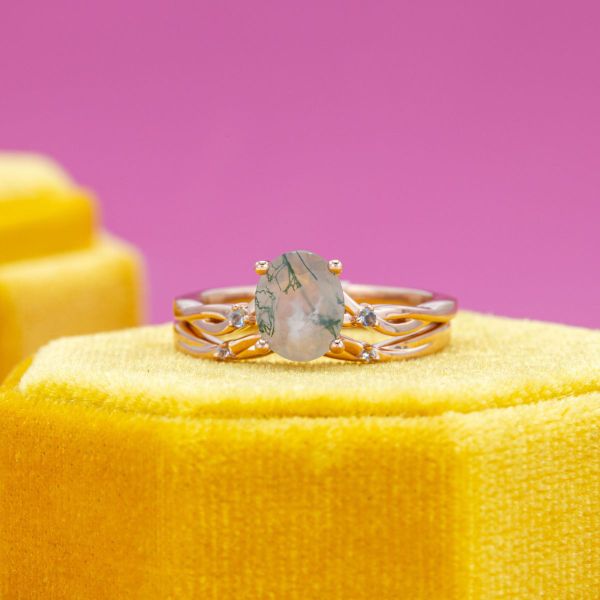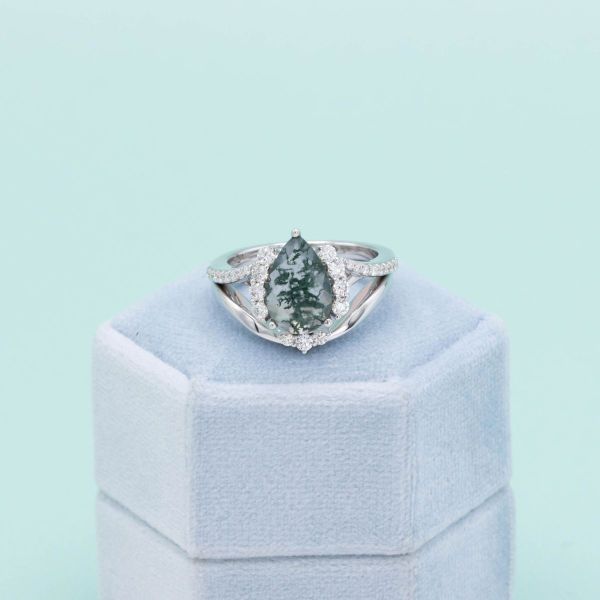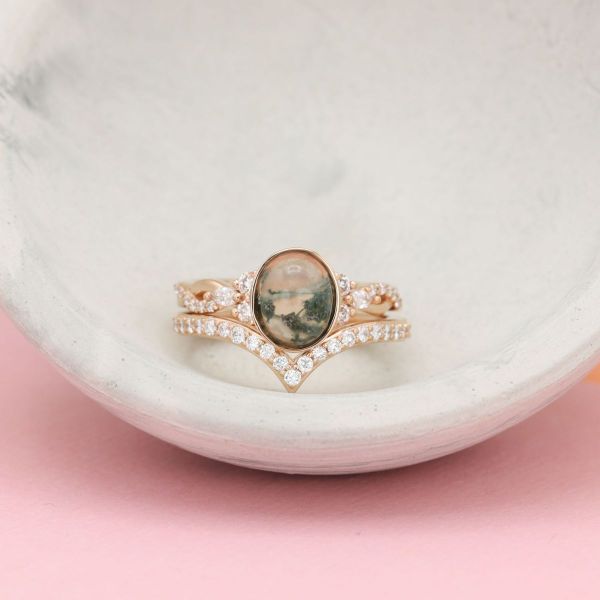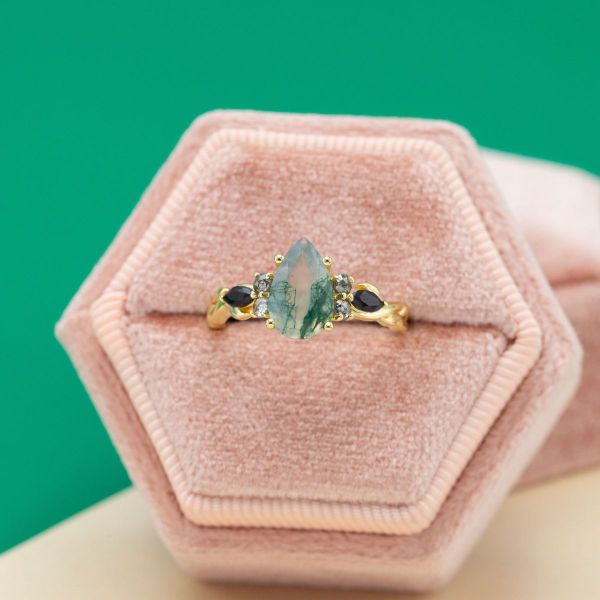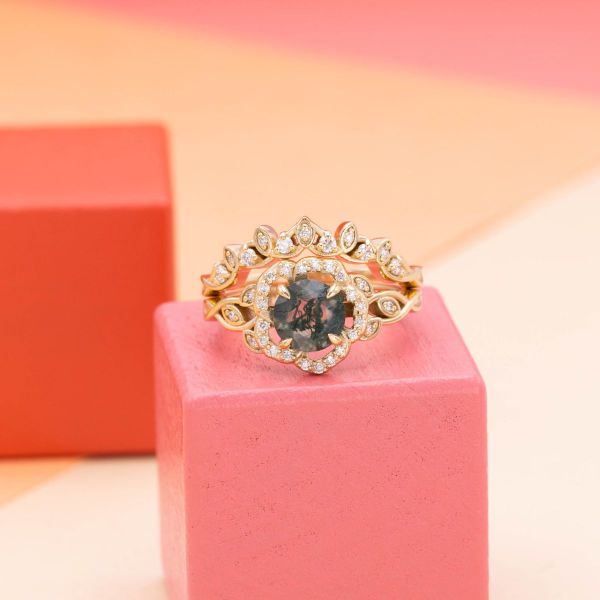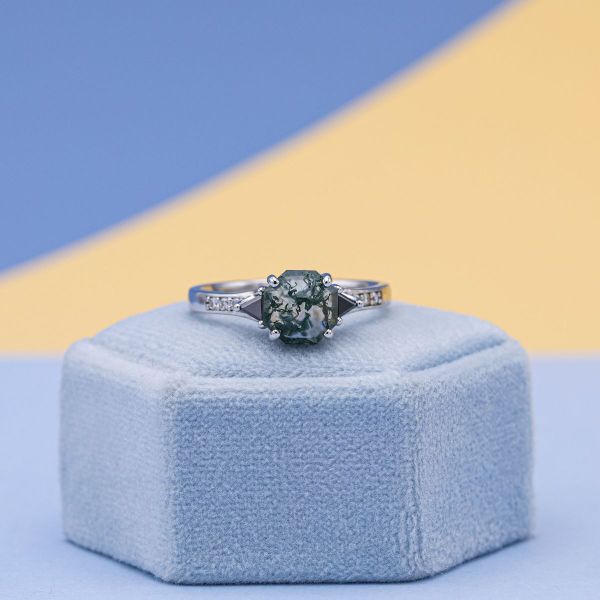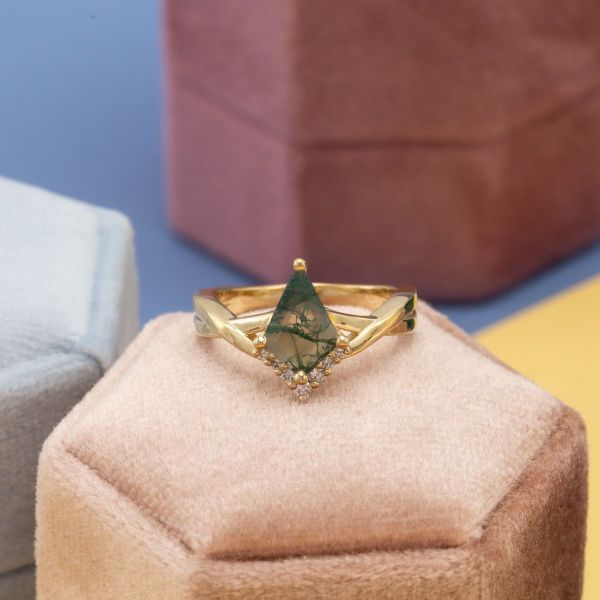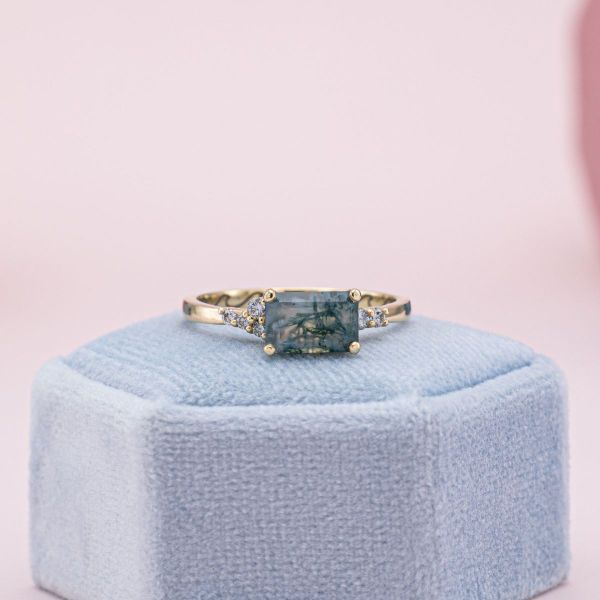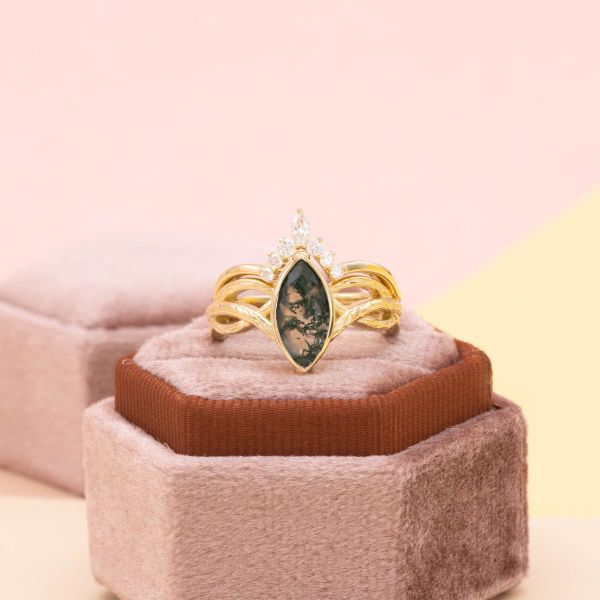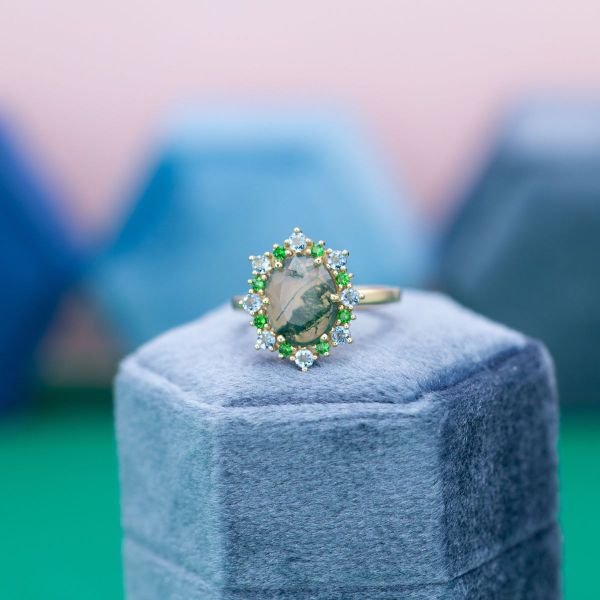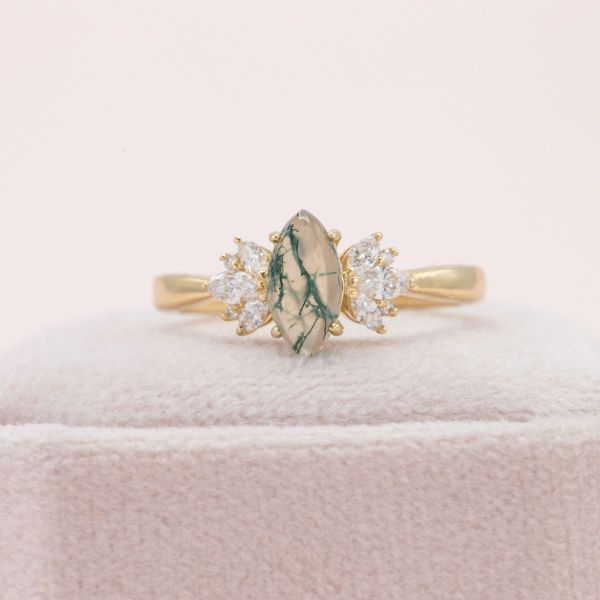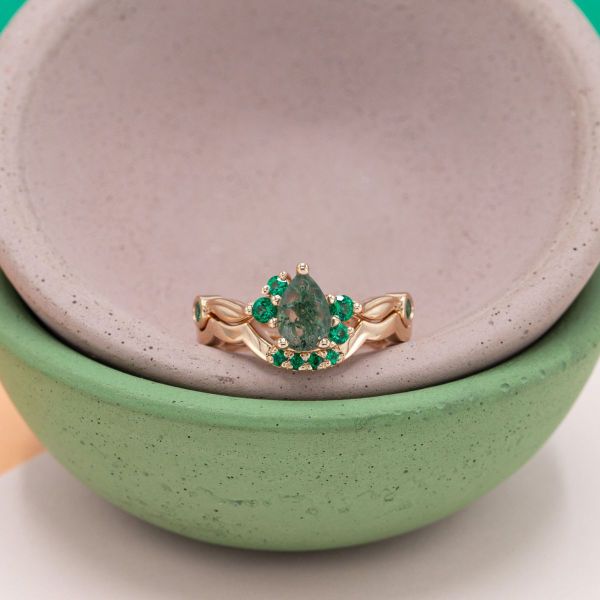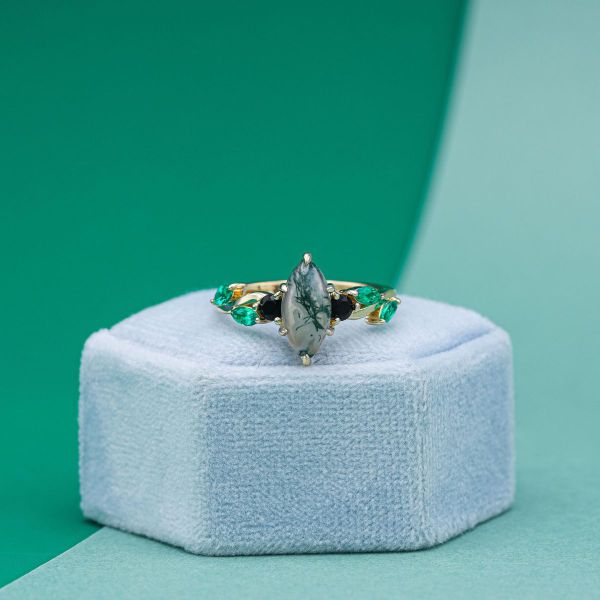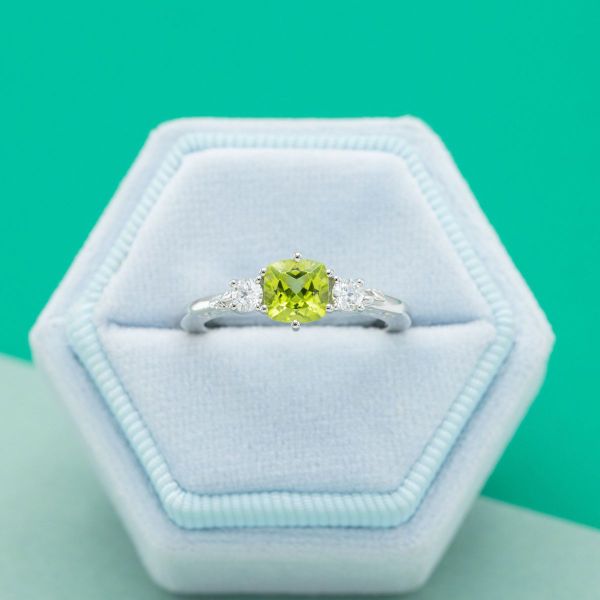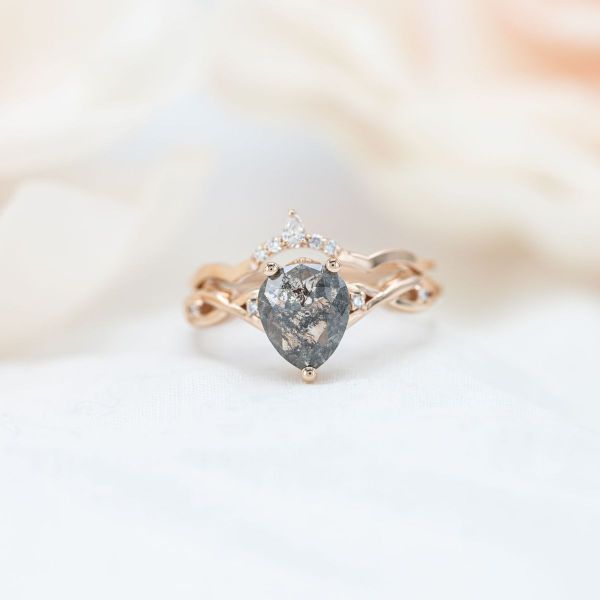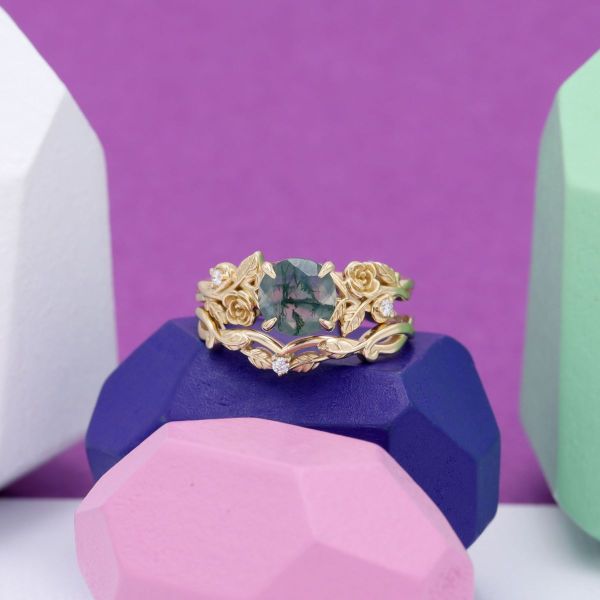Gemstone Knowledge
How to pick the perfect moss agate
A guide for choosing your ideal moss agate.
Saying “I do” to moss agate
Congratulations on choosing moss agate as the center stone of your engagement ring! There’s nothing quite like the nature-inspired appeal of this mossy stone, and it’s quite different from more common engagement ring stones like diamond, sapphire, and ruby. In fact, moss agate doesn’t follow the 4Cs or any specific selection criteria commonly used by experts to determine quality in gemstones. So, how can you be sure you’re getting the best moss agate for your engagement ring? Luckily, moss agate’s quality is fairly standard, so all you really need to worry about is color, inclusion patterns, stone shape, and your ideal setting. Moss agate offers wearers plenty of possible combinations, so let’s dive into some of the decisions you’ll need to make to find your perfect moss agate.
What to look for in moss agate
Color
It may seem like a simple decision: moss agate is green and white, so that’s what you’ll get with every stone, right? There’s actually more variation than you might think! There are multiple color and pattern options when it comes to moss agate, so investigating possible combinations is a great place to start your search.
Some moss agates have a translucent background that allows you to see through the stone and take in all of those lovely colors, meaning you can see inclusions at varying levels within the stone for extra dimension. The clear backdrop also gives light more opportunity to enter and exit the stone for a bit more of that traditional gemstone sparkle. On the other hand, some stones have a frosty or milky white backdrop, which limits your ability to stare deeply into the stone. However, their white color offers a stark contrast to moss agate’s signature green inclusions, making them pop even more. White stones are more opaque, meaning they provide rich hues that look amazing in pretty much any cut.
Inclusions—those verdant green veins and patches that give moss agate its nature-themed appeal—can vary in color as well, ranging from a lighter green to a deep forest color depending on their location and pattern (but more on that in a minute!). What’s more, some inclusions can take on a slightly different look depending on whether the backdrop of the stone is translucent or white. On rare occasions, you can even find moss agate with red or brown inclusions, adding a touch of warmer color to the stone’s otherwise cool aesthetic. So color isn’t as simple as “green and white”, and exploring all your options is a virtue when it comes to choosing the right moss agate for you! Be sure to look at plenty of stones to see if you prefer a clear or white backdrop for your moss agate.
Peruse those patterns
When choosing a moss agate, another decision that goes hand-in-hand with exploring color is inclusion patterns. So what’s inside moss agate that makes it so special? Is it real moss?! Not exactly, but it’s rife with gorgeous green mineral inclusions that take on various forms for a completely different look in every stone. As such—and we can’t stress this enough—it’s important to take some time to look at several moss agates along your journey to decide which pattern is right for your engagement ring, as each one is different!
We mentioned that moss agate’s green inclusions come in several patterns, ranging from green veins that dart across the stone to misty swirls and colored patches for a richer green hue. The combination of the stone’s base color and these inclusions means there’s a wide variety of styles to choose from. Many couples love translucent moss agates with sharp green lines or a few splashes of green color that give ample space for light to enter the stone and brighten up those inclusions. In contrast, others prefer moss agates that look like a forest covered with freshly fallen snow thanks to their frosty white backdrops and deep green splotches. There are even some moss agates that are so heavily included they seem to be filled with different shades of green with hardly any background color in sight.
These are just a few examples of color and pattern combinations, and which one you’ll love most is entirely up to you!
Shape and setting
Just like people, moss agates come in all shapes and sizes, but some may suit your personal tastes and preferred settings better than others. Brilliant cuts bring out the sparklier side of moss agates with translucent backgrounds and give just a hint of sparkle to those with white as their base color. Round, marquise, oval, pear, and princess are just some of the brilliant cut shapes you can choose that look stunning with moss agate.
Cuts with fewer facets allow you to view those vibrant inclusions whether your stone’s backdrop is clear or white. Kite, hexagon, and emerald cuts have large, flat tables that are ideal for gazing into those mossy patterns, giving plenty of space to adore that bright color and larger inclusions. Cabochons, or non-faceted stones, are also great for moss agate, with a smooth, domed surface that produces an almost three-dimensional effect on inclusions.
Shape ties into setting as well, and moss agates with points or corners may need a little extra protection from breakage thanks to their inclusions that make thinner edges more prone to chipping. Silhouettes like marquise, pear, princess, kite, and hexagon all have points that need to be protected if you tend to hit your ring against any and every surface (we can relate!), so consider a secure setting for these shapes. This can mean a halo, V-prongs, or even a bezel to protect the most delicate parts of your moss agate! They’re also great for those wearers who live life on the edge–or just have an active lifestyle–as they’ll protect the corners and edges of your stone from unwanted dings and scrapes during physical activities.
Finally, the metal you choose also makes a difference when it comes to moss agate. Rose gold is perfect for couples who want an eye-catching ring that stands out among other engagement styles. Yellow gold brings out the richness of those green inclusions, and white gold or platinum can provide a cool appeal as well as a more traditional engagement look. Shape and setting are equally important factors in the overall appeal of your ring, so spend a little time mixing and matching styles to find what’s right for you.
Accent stones
We know what you’re thinking: moss agate is so unique, what accent stones could possibly pair well with it? Don’t worry: much like accent stones on the band of an engagement ring, we’ve got you covered! While moss agate certainly has a one-of-a-kind look, that doesn’t mean it can’t pair well with other gemstones.
Two common picks that can match any aesthetic are diamonds and moissanite, boasting a neutral white sparkle that brings some traditional engagement ring brilliance to your moss agate design. For a splash of color, sapphires, tsavorites, and red tourmaline can pair harmoniously with the vibrant green hues of moss agate. For modern day witchy vibes, moonstone or opal offer a touch of colorful, opaque mystique to moss agate’s white and green aesthetic. You can even combine colors to create a bouquet of floral hues that match moss agate’s nature-inspired appeal. Overall, what matters most is that you love your ring, so don’t be afraid to mix and match stones, metals, and more for a completely personalized engagement ring. It is yours after all!
Moss agate alternatives
One of the best features of moss agate is its individuality: there’s no other stone that exactly matches its natural beauty. However, if you’re looking for an alternative stone with equally unique appeal, we have a few options to consider.
Peridot
If a green stone is what you’re after, you may prefer the warm, springy green of peridot. A bright stone with yellow undertones, peridot contains iron which produces its unique color and signature luster. Coming in at a solid 6.5-7 on the Mohs scale, it’s also just as sturdy as moss agate with more of that traditional sparkle. In fact, peridot is sometimes called “evening emerald” because of its ability to sparkle in both natural and artificial light for a glittering display in any setting.
If you still want a stone with unique beginnings, peridot can sometimes be found in fallen meteorites and volcanic lava, giving some stones a pretty cool origin story. Peridot was even once found in comet dust retrieved by the Stardust robotic space probe, so it’s truly out of this world! And the best part: peridot costs roughly $225-$200 for a 1 carat stone, so it’s affordable as well as a perfect choice for center and accent stones alike.
Salt and pepper diamonds
If you’ve always been interested in diamonds but fell in love with the included appeal of moss agate, you may want to take a look at salt and pepper diamonds! These spicy stones have all of the benefits of a diamond–durability, longevity, you get the picture–with the appeal of inclusion patterns that moss agate holds. Salt and pepper diamonds typically have a black, white, and/or gray color scheme with various types of inclusions, from splotches or swirls of color to lines, speckles, and misty patches. Much like moss agate, each diamond has its own unique pattern, so no two are the same for a one-of-a-kind engagement ring every time!
Salt and pepper diamonds are still a 10 on the Mohs scale despite their inclusions, and they come in many of the same shapes as moss agate. This means you can find translucent stones with hints of diamond sparkle as well as heavily included varieties with a more opaque look and rich color. While salt and pepper diamonds may be a more “black and white” option when compared to the green hues of moss agate, they’re certainly just as striking when set in an engagement ring.
Turquoise
Ranging from sky blue to blue-green, there are several variations of turquoise to choose from, and–much like moss agate–every stone is different. Many turquoise stones have a veined look similar to that of moss agate thanks to their “matrix” or spiderweb-like inclusions that give each stone its own personality. There are even green varieties of turquoise with chromium and vanadium for an organic, mossy look reminiscent of moss agate.
Turquoise ranges in hardness from 3 to 7.5 on the Mohs scale depending on its matrix, so durability is definitely something to consider. However, taking off your ring for daily activities that may involve chemicals or potential contact with a hard surface can go a long way in preserving your turquoise center stone. Much like peridot and moss agate, turquoise costs roughly $125-$200 for a center stone, which is very affordable overall.
Choosing moss agate
Choosing a stone like moss agate that presents so many style options can be daunting, but that’s why it’s good to look at multiple varieties to get a better idea of which one speaks to you! While you may not know right now whether a white or translucent backdrop works for you, comparing stones with varying patterns and colors will quickly show you which one best suits your personal tastes. Plus, if you already know what type of setting you’d like, you can start there and figure out which style of moss agate looks best with that particular ring. And, of course, our team at CustomMade is always standing by to help you sort through the many moss agate options to create your dream engagement ring!
About CustomMade
CustomMade designs and creates one-of-a-kind, custom engagement rings and fine jewelry. Each piece we create is inspired by you, designed for you, and made just for you.

